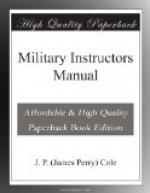(2) HAND AND RIFLE GRENADES:
Unboxed grenades should be kept covered as far as possible. All safety pins and working parts, especially those made of brass, should be kept oiled to prevent their setting from corrosion by the gas.
(3) LIGHT TRENCH MORTARS AND THEIR AMMUNITION:
As far as the supply of oil permits, the bore and all bright parts of light trench mortars and their spare parts should be kept permanently oiled. When not in use, mortars should be covered with sacking or similar material.
Unboxed ammunition should be kept covered as far as possible and the bright parts oiled immediately after arrival. Ammunition which has been in store for some time should be used up first.
Sentries must be prepared to give the alarm on the first appearance of gas, as a few seconds delay may involve very serious consequences. Signals must be passed along by all sentries as soon as heard.
The earliest warning of a gas attack is given:
(a) By the noise
of the gas escaping from the cylinders.
(b) By the appearance
of a cloud of any color over the enemy’s
trenches.
If the attack takes place at night, the cloud will
not
be visible from a distance.
(c) By the smell
of the gas in listening posts.
(1) ACTION TO BE TAKEN IN THE TRENCHES
ON GAS ALARM:
(a) Respirators
to be put on immediately by all ranks (a
helmet,
if no box respirator is available).
(b) Rouse all
men in trenches, dug-outs and mine shafts, warn
officers
and artillery observation posts and all employed
men.
(c) Artillery
support to be called for by company commanders by
means
of prearranged signals.
(d) Warn battalion
headquarters and troops in rear.
(e) All ranks
stand to arms in the front trenches and elsewhere
where
the tactical situation demands.
(f) Blanket curtains
at entrances to protected shelters to be
let
down and carefully fixed.
(g) Movement to
cease except where necessary.
(2) ACTION TO BE TAKEN IN BILLETS
AND BACK AREAS:
(a) All men in
cellars or houses to be roused.
(b) The blanket
curtains of protected collars, etc., to be let
down
and fixed in position.
(c) Box respirators
to be put on immediately, the gas is
apparent.
H. Action During a Gas Attack:
(1) PROTECTIVE MEASURES:
There should be as little moving about and talking as possible in the trenches. Men must be made to realize that with the gas now used by the enemy, observance of this may be essential for their safety.
When an attack is in progress, all bodies of troops or transport on the move should halt and all working parties cease work until the gas cloud has passed.
If a relief is going on, units should stand fast as far as possible until the gas cloud has passed.




